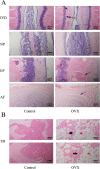Osteoporosis of the vertebra and osteochondral remodeling of the endplate causes intervertebral disc degeneration in ovariectomized mice
- PMID: 30201052
- PMCID: PMC6131954
- DOI: 10.1186/s13075-018-1701-1
Osteoporosis of the vertebra and osteochondral remodeling of the endplate causes intervertebral disc degeneration in ovariectomized mice
Abstract
Background: Studies on the relationship between osteoporosis and intervertebral disc degeneration (IVDD) are inconsistent. Therefore, we assessed whether IVDD is affected by vertebral osteoporosis in ovariectomized mice and investigated the underlying pathogenesis of IVDD related to osteoporosis.
Methods: Thirty healthy female C57BL/6 J mice aged 8 weeks were randomly divided into two groups: a control group (sham operation, n = 15) and an ovariectomy group (OVX; bilateral ovariectomy, n = 15). At 12 weeks after surgery, the bone quantity and microstructure in the lumbar vertebra and endplate as well as the volume of the L4/5 disc space were evaluated by microcomputed tomography (micro-CT). The occurrence and characteristic alterations of IVDD were identified via histopathological staining. The osteoclasts were detected using tartrate-resistant acid phosphatase (TRAP) staining. Type II collagen (Col II), osterix (OSX), osteopontin (OPN), and vascular endothelial growth factor (VEGF) expression in the intervertebral disc were detected by immunohistochemical analysis.
Results: OVX significantly increased the body weight and decreased the uterus weight. Micro-CT analysis showed that osteoporosis of the vertebra and osteochondral remodeling of the endplate were accompanied by an increase in the endplate porosity and a decrease in the disc volume in the OVX group. Likewise, histological evaluation revealed that IVDD occurred at 12 weeks after ovariectomy, with features of endochondral ossification of the endplate, loose and broken annulus fibrosus, and degeneration of nucleus pulposus. TRAP staining showed that numerous active osteoclasts appeared in the subchondral bone and cartilaginous endplate of OVX mice, whereas osteoclasts were rarely detected in control mice. Immunohistochemical analysis demonstrated that the expression of osterix was significantly increased, notably in the endplate of OVX mice. In addition, Col II was decreased in the ossification endplate and the degenerative annulus fibrosus, where OPN and VEGF expressions were elevated in OVX mice.
Conclusions: OVX induced vertebral osteoporosis and osteochondral remodeling of the cartilaginous endplate contributing to the angiogenesis and an increase in porosity of the bone-cartilage surface, and also affected the matrix metabolism which consequently had detrimental effects on the intervertebral disc. Our study suggests that preserving the structural integrity and the function of the adjacent structures, including the vertebrae and endplates, may protect the disc against degeneration.
Keywords: Endplate; Intervertebral disc degeneration; Microcomputed tomography; Osteochondral remodeling; Osteoporosis; Ovariectomy.
Conflict of interest statement
Ethics approval
Animal studies were performed under institutional guidelines and in accordance with protocols approved by the Ethics Committee, Guangzhou University of Chinese Medicine.
Consent for publication
Not applicable.
Competing interests
The authors declare that they have no competing interests.
Publisher’s Note
Springer Nature remains neutral with regard to jurisdictional claims in published maps and institutional affiliations.
Figures










References
Publication types
MeSH terms
LinkOut - more resources
Full Text Sources
Other Literature Sources
Research Materials

